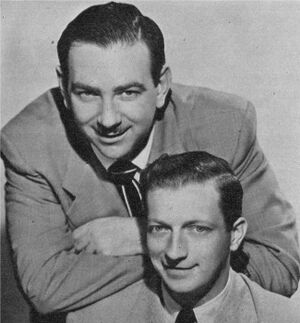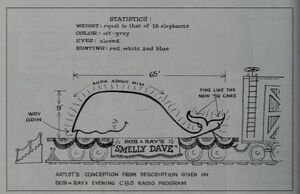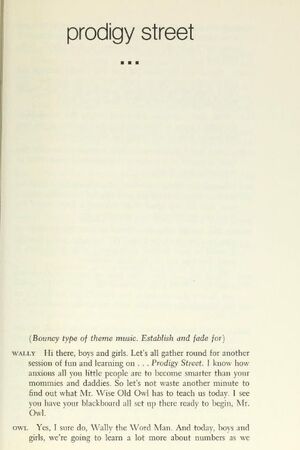
Ray Goulding, top, and Bob Elliott

Smelly Dave, with a "certain aura about him," as rendered by Michael J. Smollin for Bob and Ray Present the CBS Radio Network

"Prodigy Street" script in the 1975 book Write If You Get Work
Bob and Ray were a comedic duo best known for their often surreal work on radio. Bob Elliott (1923-2016) and Ray Goulding (1922-1990) first teamed in 1946, and remained on the air (over different networks and slots) more or less continuously through 1960, with the same basic format: the duo doing all voices in spoofs of soap operas (notably "Mary Backstayge, Noble Wife"), radio dramas, and other "epics." This was followed by commercials, sporadic radio returns and revival series in the 1980s, a Broadway show, television, and records.
Surrounding the spoofs were inane interviews, dubious "experts," strange fake giveaways, and a gallery of oddballs. Bob's characters included inept adenoidal reporter Wally Ballou, old men, and impersonations of Arthur Godfrey (Arthur Sturdley) and Peter Lorre. Ray, in addition to various loudmouths and hotheads, played all the female roles but with the same voice, used for household tips expert Mary McGoon, as well as Charles the Poet (who broke into laughter in every recitation) and others.
The pair started their own agency to handle commercials, and employed Michael J. Smollin as a staff illustrator and storyboard artist (prior to his long-term work as a Sesame Street book illustrator). Bob and Ray's 1959-1960 CBS series included the saga of Smelly Dave, the dead whale who they sent on an extended national tour on an open flatcar (with odoriferous results). When he was "whalenapped," Smollin created an artist's rendition as a promotional giveaway (real for once). He also supplied back cover art of their characters for their 1960 album Bob and Ray on a Platter (two selections were used on Sam and Friends).
Bob and Ray really came to national attention in the early 1950s, and they were still rising just as puppeteer Jim Henson was barely beginning. Their shared sense of absurd led to occasional comparisons in the press (especially between their commercial work).
Bob and Ray and Jim[]
In Goulding's obituary, one journalist even suggested that "I'll bet a young Jim Henson was out there listening, or there would never have been a Kermit the Frog,"[1] specifically comparing his news career to that of Bob and Ray's reporter Wally Ballou. There was indeed a certain parallel development, since Bob and Ray entered television in 1951 in a sporadic NBC series (adapting radio material but with Audrey Meadows and later Cloris Leachman as the soap heroines), were heard on NBC's radio series Monitor from 1955 through 1959 (overlapping with Sam and Friends), and entered advertising in the 1950s (notably giving voice to Bert and Harry Piels in a series of animated beer ads).
Veteran ad copywriter Ed Graham, who formed ad agency Goulding-Elliott-Graham Productions with the team around 1956, recalled an early encounter with Jim Henson when he and Jane Nebel brought their puppets around: "I thought they were good, but I never liked puppets and neither did B&R. Jim found work shortly afterwards."[2]
Henson's work would include coffee commercials and other spots in 1957 which would receive the same welcome critical reception as G-E-G's Piels campaign had. However, from 1955 until 1958, Henson was still busy with his first all-Muppet series, Sam and Friends and various guest appearances, most of which had Muppets lip-synching to popular songs, novelty records, and radio routines... including Bob and Ray, as in "The Westerners." As two typically inept Bob and Ray cowboys, Kermit lip-synchs to Bob and Chicken Liver lip-synchs to Ray.
Henson's unlicensed use of such material occasionally drew attention (such as a cease and desist request from Stan Freberg in 1957). Freberg was won over by the act, as often happened in these situations.[3] In Bob and Ray's case, when they saw it, Bob Elliott recalled that "Stupidly, we got a cease-and-desist order, rather than see it was a wonderful promotion for us." They sent their friend and attorney Stan Schewel, "whose warm, easygoing Virginia overtones existed side by side with an abrupt, lawyer-like command of the language" and "could make a thank you note sound like a threat."[2]
Still, Bob and Ray and Henson's Muppets continued on their respective paths to fame, and by 1985, Bob and Ray were among the many celebrities featured in Night of 100 Stars.
Later careers[]
The pair made frequent talk show appearances. In 1970, they repackaged their routines for the Broadway show Bob and Ray: The Two and Only.. More TV and film work followed, including the Norman Lear film Cold Turkey (appearing separately to parody news personalities like Hugh Downs, Chet Huntley, and Walter Cronkite). During this period, they also supplied voices for cartoon inserts on The Electric Company. Their 1979 special Bob and Ray, Jane, Laraine & Gilda spotlighted the usual nonsense, but with Jane Curtin, Laraine Newman, and Gilda Radner in the female roles.
References[]
- Early animated Sesame Street inserts featured little girl Gloria singing "The Alphabet Song" (variations appeared in the pitch reel and test shows, in the first season, and with a new closing line first used in Episode 0134). In all versions however, Gloria is admonished by an off-screen female teacher, voiced by a man doing an impression of Mary McGoon.
- When introducing Ernie and Bert in The Muppet Show episode 102, Kermit refers to them as "the two and only," the title for Bob and Ray's stage show which later became a popular nickname for the team.
Muppet Mentions[]
An occasional sketch in Bob and Ray's 1970s and 1980s shows was "Prodigy Street," a Sesame Street spoof. The 1970s versions sampled the theme recording from the 1973 album Sesame Street LIVE! "Prodigy Street" is targeted to "little peoples anxious to become smarter than your mommies and daddies." Rather than including direct Sesame character parallels, each sketch focused on the byplay between Wally the Word Man (Bob) and the mathematically inclined Mr. Wise Old Owl (Ray). Their interactions became increasingly rancorous as they disputed the show's curriculum focus (usually the smug Wally interfering), sometimes including references to the foundation which funds the show, and always ending with a violent altercation and cartoonish sound effects. At least four sketches exist.
- 1975, NYC radio station WOR: Mr. Wise Old Owl tries to teach about the number 1, but Wally interrupts to bring up phonetic sounds and dismisses the usefulness of addition. Mr. Wise Old Owl punches Wally. Published in the collection Write If You Get Work (1975) and later reprinted in the 1988 anthology The Random House Book of Humor for Children.
- March 18, 1976, WOR: Mr. Wise Old Owl attempts a lesson on multiplication. Wally claims every number resembles a letter, comparing 2 to the letter Z (which starts the words zebra, zoo, and Zimmerman).
- March 1, 1987, NPR: Reversing their usual roles, Mr. Wise Old Owl opens the show and interrupts Wally's lesson on punctuation to bring up mathematics, and Wally delivers the closing punch. The entire episode was an NPR fundraising show.
- March 15, 1987, NPR: The acrimony between Wally and Mr. Wise Old Owl is at its most blatant, with Wally dismissing long division, even before the owl starts, as "dullsville" and that he discouraged him from using it on the show. Wally keeps trying to bring up more entertaining songs, and when Mr. Wise Old Owl claims husky boys sound like "sissies" when singing "The Three Little Kittens," Wally brings up how chauvinistic this is and threatens to snitch to the foundation. Mr. Wise Old Owl knocks out Wally's teeth.
Sources[]
- ↑ Osgood, Charles. "Bob and Ray brought magic to radio." Chicago Sun Times. April 2, 1990
- ↑ 2.0 2.1 Pollock, David. Bob and Ray: Keener Than Most Persons. 2013. p. 135-236.
- ↑ Jones, Brian Jay. Jim Henson: The Biography. 2013. p. 62-63
